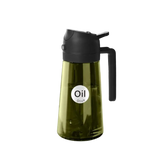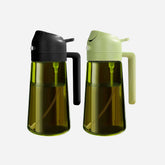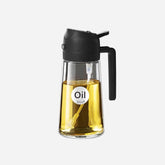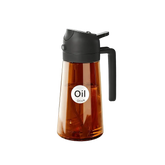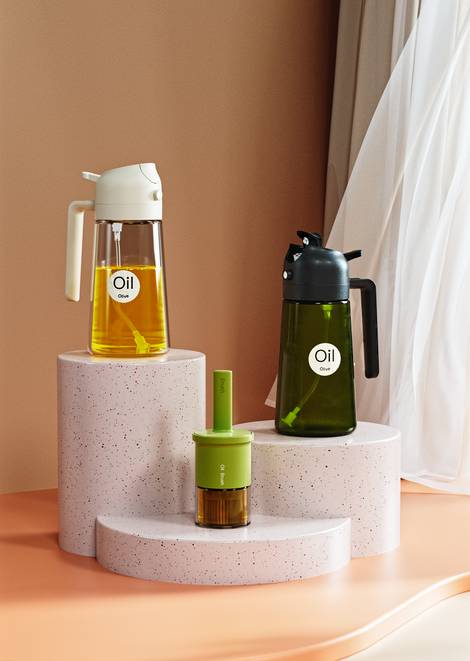10 Common Oil Sprayer Mistakes You’re Probably Making
Title: 10 Common Oil Sprayer Mistakes You’re Probably Making (And How to Fix Them)
Oil sprayers are kitchen heroes, especially for some special cooking. Whether you’re using an air fryer sprayer, the best cooking oil dispenser you could find online, or a simple cooking oil spray container, these tools can turn into messy headaches if used incorrectly. Let’s break down the top mistakes people make (you might be guilty of a few) and how to avoid them like a pro.

1. Are You Using the Wrong Type of Oil in Your Sprayer?
Not all oils work well in sprayers. Thick oils like coconut oil or cold-pressed olive oil can clog nozzles, while overly refined oils might leave residue. For air fryer sprayers, lightweight oils like avocado or grapeseed are ideal—they mist evenly and won’t gunk up the mechanism.
Pro tip: If your cooking oil spray container feels sticky, you’re likely using an oil with low smoke points or additives. Stick to pure oils labeled “high heat” for smoother spraying.
2. Overfilling the Container? Here’s Why That Backfires
“More oil = less refills, right?” Wrong. Overfilling your best cooking oil dispenser creates pressure issues, leading to leaks or uneven sprays. Most sprayers work best at ¾ capacity. Bonus: Leaving space lets you shake the bottle for better oil distribution before spraying.
3. Forgetting to Clean the Nozzle After Every Use
That tiny nozzle is ground zero for clogs. Leftover oil hardens and blocks the spray—especially in air fryer sprayers exposed to heat. After each use, wipe the nozzle with a warm cloth and do a deep clean weekly (soak in vinegar or dish soap). Your future self will thank you.
4. Shaking the Bottle Like a Maraca—Are You Doing It Wrong?
Aggressive shaking introduces air bubbles, causing sputtering instead of a fine mist. Gently tilt the cooking oil spray container sideways and swirl to mix oil without aerating it. For thicker oils, warm the bottle in lukewarm water first to improve flow.
5. Storing Your Sprayer Next to the Stove? Big Mistake
Heat degrades oil quality and warps plastic components. Keep your best cooking oil dispenser in a cool, dark place (not next to your sizzling skillet!). Oils like olive or flaxseed are light-sensitive—opaque or stainless steel containers work best.
6. Using Cooking Sprays With Additives in Non-Stick Sprayers
Store-bought aerosol sprays often contain emulsifiers like soy lecithin. These leave sticky residues in reusable air fryer sprayers, reducing their lifespan. Opt for pure oil in refillable containers—your wallet and cookware will benefit.
7. Ignoring the “Pump Priming” Step
New to manual sprayers? Pumping the trigger 3–5 times before spraying creates pressure for a consistent mist. Skipping this = sad, dribbly oil. For electric cooking oil spray containers, ensure batteries are fresh to avoid weak sprays.
8. Assuming All Sprayers Work for High-Heat Cooking
That cute mini sprayer from the discount aisle? It might melt under high temps. Check the manufacturer’s heat tolerance—most air fryer sprayers handle up to 400°F. For searing or grilling, use stainless steel or heat-resistant glass models.
9. Reusing Old Oil in Your Dispenser? Yikes.
Leftover oil collects food particles and turns rancid, contaminating fresh batches. Always empty and clean your best cooking oil dispenser before refilling. If you’re frugal, repurpose old oil for non-cooking uses (e.g., seasoning cast iron).
10. Not Testing the Spray Pattern Before Cooking
Nothing ruins a dish faster than a sprayer that squirts instead of mists. Before coating your air fryer basket, test the spray on a paper towel. Adjust the nozzle or shake the bottle if needed—consistency is key for even cooking.
Ready to Upgrade Your Oil Sprayer Game?
Mastering your cooking oil spray container isn’t rocket science—it’s about avoiding these sneaky pitfalls. Whether you’re air-frying, baking, or sautéing, a little TLC for your sprayer ensures crispy, golden results every time. So ditch the guesswork, follow these fixes, and let your kitchen gadgets shine (without the grease stains).





